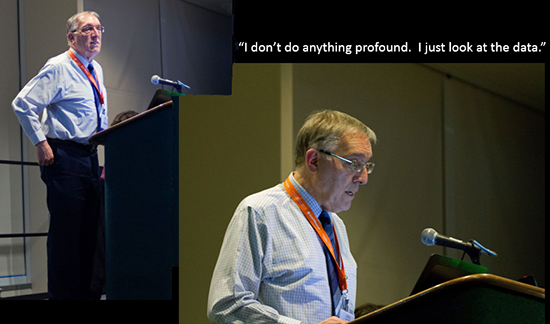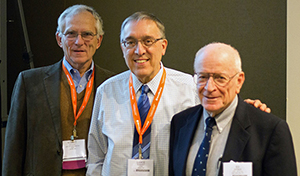An Atmosphere of Praise
 |
|
Lance Bosart addresses his admiring colleagues at the Lance Bosart Symposium held at the American Meteorological Society meeting. (Photos and display by Robert Fovell) |
ALBANY, N.Y. (February 6, 2017) — A lifetime of contributions to meteorology do not go unnoticed. So said the 97th annual meeting of the American Meteorological Society, which devoted its final day to the Lance Bosart Symposium.
Bosart, distinguished professor in the Department of Atmospheric and Environmental Sciences (DAES),was honored for his vast influence on synoptic-dynamic meteorology — the study of weather processes occurring over a horizontal range of 1,000 kilometers or more — during the meeting, which was held Saturday, Jan. 21, through Thursday, Jan. 26, at the Washington State Convention Center in Seattle.
Wednesday’s events included a Bosart Symposium Poster Session, where UAlbany atmospheric scientist Kristen Corborsiero and Neil Stuart of the National Oceanic and Atmospheric Administration and the National Weather Service in Albany noted Bosart's “Impacts in the Operational Forecasting Community and Beyond.”
Then came Thursday’s symposium, run as Bosart would have wished: four sessions of scientific presentations on the state of the field and its various areas of study. Many tributes were included in these presentations, honoring Bosarts nearly 50 years of dedicated research and teaching.
 |
|
Lance Bosart with long-time colleagues and fellow venerated atmospheric scientists R.A. Houze, left, of the University of Washington, and Edward Zipser of the University of Utah. |
“It was a big celebration,” said Christopher Thorncroft, professor and chair of DAES. “So many friends, peers, former students and former post docs coming together to honor Lance and his career.”
Session 1 was on “Weather Forecasting Challenges.” It included a tribute from Paul J. Roebber, distinguished professor at the University of Wisconsin-Milwaukee. “The list of Lanceisms is quite long indeed,” wrote Roebber. “But these aphorisms are not just pithy word candy, they also contain lessons that we have adopted in our own scientific and educational pursuits. What could be more important for our discipline than Lance’s admonition to ‘be prepared to be wrong?’”
Session 2 was “Mesoscale Precipitation Events," with a tribute from Professor Robert A. Houze of the University of Washington “Lance Bosart has made countless important contributions to synoptic-scale meteorology: tropical cyclone transitions, the synoptic contribution to the Johnstown flood storm, cold air damming, to name a few,” said Houze. “Less obvious are his indirect contributions by influencing and inspiring other researchers as a role model for how to do observational research.”
The sessions broke for a tribute-laden Lance Bosart Luncheon, followed by Session 3 on “Tropical Interactions With Higher Latitudes.” Session 4 on “Severe Local Storms included a tongue-in-cheek tribute from Morris Weisman of the National Center for Atmospheric Research in Boulder, Colo., on the subject of derechos — widespread long-lived wind storms associated with fast moving thunderstorms: “Derechoes: One of Lance Bosart's Favorite Long-winded Topics.”
The final session concluded only after Bosart had his turn to contribute, modestly, with “Confessions of an Accidental Meteorologist: Meteorology Then, Now, and ????”
He noted: “From the perspective of someone who entered the field in the paper map, grease pencil, and teletype era, who survived the changeover to the electronic arena, and who now lives in the ‘you can get anything you want at any time in any place’ on-demand internet era, the changes in the field of meteorology over the last 50 years have been stunning in their swiftness, especially since the turn of the 21st century.”
“It was an amazing day and very well attended,” said Thorncroft. “The last session was standing-room only — and many tears were shed."
But, as he has for his entire four decades of research and teaching, Bosart came to the conference not to be feted, but largely to work, contributing to more than a dozen presentations during the course of the six days. That was only what colleagues have come to expect.
“Lance Bosart’s research contributions to atmospheric sciences have been so monumental that his legacy will live for decades to come,” said Roger W. Wakimoto of the National Science Foundation. “I consider myself fortunate that our research paths have crossed a number of times.”
![]() For more news, subscribe to UAlbany's RSS headline feeds
For more news, subscribe to UAlbany's RSS headline feeds
A comprehensive public research university, the University at Albany-SUNY offers more than 120 undergraduate majors and minors and 125 master's, doctoral and graduate certificate programs. UAlbany is a leader among all New York State colleges and universities in such diverse fields as atmospheric and environmental sciences, business, education, public health,health sciences, criminal justice, emergency preparedness, engineering and applied sciences, informatics, public administration, social welfare and sociology, taught by an extensive roster of faculty experts. It also offers expanded academic and research opportunities for students through an affiliation with Albany Law School. With a curriculum enhanced by 600 study-abroad opportunities, UAlbany launches great careers.


